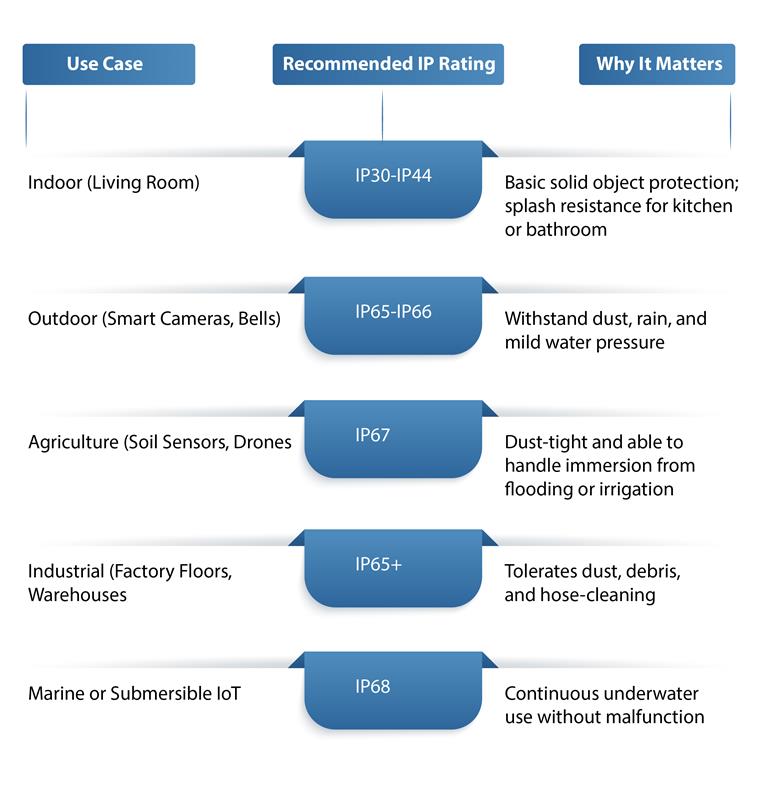Comprehending the ‘IP Rating’ of Your Android Device
A mobile device’s ingress protection (IP) rating pertains to its defense against both dust and moisture. This rating starts with “IP” and is followed by either two digits or a single digit with an “X” in one of the positions. Understanding this information is crucial as it will (or should) guide how and where you utilize your device. There are significant differences between the values. A typical rating is IP68, representing the utmost level of safeguard against dust particles as well as the capability for the device to be submerged in a specified depth of water for a defined period.
An essential detail to recognize regarding a water-resistant rating is that it applies to freshwater sources, like a bathtub at home or a swimming pool with a moderate level of chlorine. However, this rating does not safeguard the phone against saltwater, which may damage electronic parts. Therefore, taking it into the ocean could potentially nullify the warranty. Only the highest ratings address temperature variations and high-pressure sprays. Additionally, water resistance diminishes with time, meaning a device you’ve owned for several years won’t maintain the same level of protection as when it was brand new.
What do IP ratings signify?
Aqara Presence Multi-Sensor FP300 Unveils Motion Automation and Thread Capabilities for HomeKit Smart Homes
### Aqara FP300: The Next Generation Presence Sensor for HomeKit Users
Aqara has introduced the FP300, a state-of-the-art presence sensor specifically engineered for HomeKit users desiring dependable automation without relying on cameras. This groundbreaking device merges mmWave presence sensing technology with a conventional PIR sensor, while also delivering measurements for light, temperature, and humidity. Notable features for Apple users include compatibility with Thread and Matter, facilitating smooth integration with the Home app for effective, room-aware automations.
#### What Makes FP300 Interesting for HomeKit
Presence detection is fundamentally different from simple motion detection. Conventional PIR sensors sense motion and cease operation once that movement stops. In contrast, mmWave technology can detect whether an individual is present in a room, even if they are stationary, such as working at a desk. The FP300 utilizes both technologies, enabling the PIR sensor to trigger quick wake-ups while the mmWave technology keeps automations active when someone remains in the room.
This integration boosts the consistency of automations linked to lighting and temperature management. The FP300 guarantees that lights do not switch off while someone is still in the room, only directing HomeKit to turn off once the room is truly vacant.
Moreover, the FP300 communicates light, temperature, and humidity levels, functioning effectively as a small brain for a room. This functionality enables smarter automations, as a single accessory can notify you of presence, brightness, and air quality.
#### HomeKit Automations You Can Build
Though the FP300 has yet to undergo testing, its features hint at various beneficial automations:
– **Smart Room Lighting**: Instantly illuminate lights upon detecting presence, dim them after a brief period of inactivity, and only switch them off once the room is vacant.
– **Bedroom Comfort Control**: If an individual is present and the temperature increases, activate a fan or decrease the thermostat. The fan will automatically shut off once the room cools down.
– **Office Lighting**: When presence is recognized and light levels dip, illuminate a desk lamp with a cooler white tone. Shift to warmer lighting in the evening if someone remains in the room.
– **Humidity-Based Automations**: If humidity levels surge while presence is identified, engage a HomeKit exhaust fan. The fan will turn off once humidity declines and the room is unoccupied.
– **Nighttime Hallways**: From sunset to sunrise, activate soft night lights in hallways or children’s rooms based on presence detection.
#### Thread and Matter Support
Thread support is a vital component of the FP300’s attractiveness. Presence sensors demand responsiveness, speed, and reliability, and Thread offers low-power, low-latency communication that isn’t reliant on Wi-Fi range. If you possess a modern Apple TV or HomePod, your HomeKit configuration likely already supports Thread.
Matter support is equally crucial. The FP300 appears in the Home app like any native accessory, removing the necessity for an extra bridge or hub (beyond an Apple TV or HomePod). Users can integrate it into scenes and automations, rename it, assign it to rooms, and utilize its data without depending solely on the Aqara app.
#### Where FP300 Fits in a HomeKit Setup
The FP300 is flexible enough to be employed in multiple rooms, including:
– **Living Room**: Maintain lamps on while individuals are present.
– **Kids’ Rooms**: Track motion, temperature, and humidity.
– **Entryway**: Take advantage of quick PIR wake-up to activate lights and mmWave technology for timely shutdown once the room is empty.
Presence sensors like the Aqara FP300 offer a beneficial solution for identifying people without the requirement for indoor cameras. The integration of mmWave and PIR technologies allows for efficient presence detection without infringing on privacy. This sensor enhances the smart home experience by enabling responsive lighting, effective fan management, and thoughtful automations.
#### Aqara FP300 Specs
Key specifications for Apple enthusiasts include:
– mmWave and PIR presence detection
– Built-in light, temperature, and humidity sensors
– Matter support over Thread
– Battery-operated design with a multi-year lifespan
– Compatibility with Apple HomeKit, Amazon Alexa, Google Home, and more
– Installable on walls, corners, or ceilings with included bracket
#### Wrap Up on Aqara FP300
The Aqara Presence Multi Sensor FP300 is set to be a great addition for HomeKit users seeking innovative motion sensing functionalities. With Thread support ensuring rapid and stable performance, alongside additional environmental sensors, the FP300 unlocks numerous possibilities for tracking and automations. On paper, it distinguishes itself as one of the most feature-packed presence sensors available for HomeKit users.
You can acquire the FP300 from
Read MoreRobert Downey Jr. Rejected a Part in an Oscar-Winning Science Fiction Movie After Iron Man
**Robert Downey Jr. Turned Down An Oscar-Winning Sci-Fi Film Following Iron Man**
Alfonso Cuarón’s “Gravity” is not just one of the sci-fi films endorsed by Neil deGrasse Tyson, but it also enjoyed tremendous popularity with the general audience. The film secured seven Oscars out of 10 nominations, including Best Director, Cinematography, and Visual Effects, grossing nearly $725 million at the box office (via Box Office Mojo). The plot revolves around two astronauts who face debris during a mission and must devise a plan to survive and return to Earth. Sandra Bullock (Ryan Stone) and George Clooney (Matt Kowalski) headline the film. Initially, however, Cuarón had a different pair in mind for the project.
Robert Downey Jr. was first approached to co-star in “Gravity” alongside Angelina Jolie. While “Gravity” was released on August 28, 2013, Cuarón filmed the project in 2011. At that time, Marvel was busy producing “The Avengers,” the inaugural crossover movie for the Marvel Cinematic Universe. Robert Downey Jr. played a pivotal role in this film after establishing himself as the face of the still-nascent MCU in “Iron Man” (2008), the movie that launched Marvel’s universe, with RDJ’s portrayal being crucial to that triumph. The sequel, “Iron Man 2,” debuted in 2010, a year preceding the commencement of “Gravity.”
The actor would have needed to balance both Cuarón’s film and the first “Avengers” outing if all parties had permitted him to shoot both concurrently. However, the conflicting schedules were not the primary reason Downey Jr. declined the role of Matt Kowalski. The actor clarified in a conversation on The Howard Stern Show, years after “Gravity’s” release, that the real challenge lay in the limitations of filming the space movie as Cuarón envisioned.
**RDJ on Being Comfortably Uncomfortable**
“Everyone ends up doing what they’re meant to do, and sometimes, someone has a motorcycle accident, and then the person who takes over the role [nails it], and you think, ‘I couldn’t have pictured anyone else in that role,'” RDJ shared with Stern in an interview in October 2022. He noted he was brought on board early in the project, even before Jolie was cast. He connected well with Cuarón and appreciated the concept. Stern pointed out that Downey Jr. had previously mentioned his inability to work within the cramped confines required by the “Gravity” sets. It was then that the actor elaborated on the filming experiences Cuarón was seeking, which he found uncomfortable.
“What I can let you know is I went in to do a test with a new kind of multi-spherical camera setup they were experimenting with for the CGI,” RDJ remembered. “I’m the type of person who can be comfortably uncomfortable pretty easily. I went in the morning to do that testing, and we lasted about 20 minutes. I asked, ‘This is insane; how much longer will it be?’ They replied, ‘It’ll be another two to four hours.’ I said, ‘No way!'” The actor further mentioned, “You’ve got to set boundaries. You’ve got to exit before you lose it,” implying that claustrophobia might have played a significant role in his decision to walk away from the sci-fi film.
**Cuarón Confirms RDJ Would Not Have Thrived in Gravity**
In a separate instance, Cuarón recounted a similar narrative to The Hollywood Reporter in 2014, discussing Downey Jr.’s withdrawal from the film, though the director provided less context than the actor did during his conversation with Stern. “It became increasingly clear that, as we started to hone the technology, that was going to be a significant hurdle for his performance,” the director explained. “I find Robert to be incredible if you grant him the latitude to fully breathe, improvise, and adapt. [However] we experimented with one of these technologies, and it just wasn’t suitable. After that, we
Read MoreUncover the Ease of Apple Gift Cards for Utilizing Apple’s Premier Services
# Grasping Apple Gift Cards and Services
If you’re a supporter of Apple, it’s likely you received at least one Apple Gift Card during the holiday season. These gift cards are applicable for purchases in the App Store, Apple Store, and various Apple services such as Apple Music and Apple TV.
## Overview of Apple Services
Apple presents a range of services that can be utilized with Apple Gift Cards. Here’s a brief overview of the services currently offered:
– **[Apple Music](https://apple.co/48lJx2o)**: A music streaming service that provides access to over 100 million tracks.
– Cost: $10.99 per month
– **[Apple TV](https://apple.co/4qXELj0)**: Provides access to popular television series and films like *Ted Lasso*, *Severance*, and *Pluribus*.
– Cost: $12.99 per month
– **[Apple Fitness+](https://apple.co/4pm7D34)**: A digital fitness platform featuring video workouts in 12 distinct workout categories.
– Cost: $9.99 per month
– **[Apple Arcade](https://apple.co/3XAbEEZ)**: A gaming subscription service with over 200 games, completely free of in-app purchases or advertisements.
– Cost: $6.99 per month
– **[Apple News+](https://apple.co/4i7bY7v)**: Offers access to leading stories and publications, daily puzzles, and comprehensive recipes.
– Cost: $12.99 per month
– **
Read MoreTop 5 Essential Steam Deck Applications for 2026
extend the lifespan of your equipment with some fantastic applications. Now that the Steam Deck has established its position in the market, numerous applications have been launched to enhance the handheld’s gaming experience. The question arises, which applications are genuinely worth utilizing? Well, that’s exactly our purpose today: We’ve compiled a list of the top five applications every Steam Deck gamer ought to install on their device. From consolidated game launchers to game streaming applications, BGR has your needs covered.
Heroic Games Launcher
The Steam Deck provides a fairly simple user interface, and while you can sideload applications and games to access from your Steam library, there are more efficient methods to keep everything organized in one location.
The Heroic Games Launcher is among the top selections to manage your multi-store game collection. Not only is the app open source (similar to the other software integrated into the Steam Deck), but it also accommodates software from various stores. From Steam to GOG to Epic to Amazon Prime Games, the Heroic Games Launcher includes them all.
Utilizing a third-party launcher like Heroic to consolidate everything in one place is convenient, but it’s also the ideal launcher to compile the free games you’ve been accumulating from sources like Epic and Amazon. Both companies provide free titles every month, and a lot of gamers frequently leave those freebies unused. This no longer has to be the situation with the Heroic Games Launcher: It’s the perfect opportunity to stop letting your backlog sit and start gaming, with the assistance of a launcher that supports all of the
Read MoreApple’s iOS Development Strategy: Transitions from iOS 26.3 to iOS 27
iOS 26.2 updates – primarily consisting of modifications to the Liquid Glass design and the enhancement of the Live Translation feature across additional languages and regions — users are keenly anticipating further features. However, in contrast to prior iOS software update cycles, Apple has been more prudent in revealing features it may not be able to deliver promptly. In previous years, the company announced a completely new CarPlay experience that took years to launch, the frequently postponed Apple Intelligence platform, and other minor features that required time to debut, like iPad’s Stage Manager, Sidecar, and more.
Following the Siri debacle and the postponement of the brand-new personal assistant, which was anticipated for iOS 18.4, Apple chose to only showcase features it could deliver simultaneously with iOS 26 during the WWDC 2025 keynote. While the company achieved that, it also left us with minimal information regarding upcoming developments. Or so we believed. Keeping that in mind, here’s an iOS roadmap with leaked and anticipated features for iOS 26.3 through iOS 27.
iOS 26.3 will introduce these features and modifications
Android Central’s Best Chromebooks and Tablets of 2025
Which Chromebooks and tablets captured our interest in 2025? Here are our top picks!
Apple Wallet Gets Two Key Feature Enhancements in iOS 26
Apple Wallet has rolled out a variety of new features in iOS 26, tackling earlier limitations and improving user engagement. Key among these enhancements are the inclusion of Digital ID and AI-enhanced order tracking.
### AI-Enhanced Order Tracking
First introduced in iOS 16, the order tracking functionality in Apple Wallet faced challenges in gaining popularity due to its dependence on external services. This reliance limited its efficiency, as numerous merchants opted to keep direct control over customer engagement. However, with improvements in iOS 26, Apple has overhauled this feature using Apple Intelligence.
Now, Wallet is capable of automatically pulling order information straight from confirmation emails sent by merchants and delivery providers. This advancement allows users to check their order status, receive progress notifications, and access other pertinent information all in one location without needing external cooperation. To utilize this feature, users can click the three-dot icon in the upper-right corner of Wallet and choose ‘Orders,’ where they can also set up push alerts for updates.
### Digital ID Without State Implementation Required
Apple’s goal to establish Wallet as a primary platform for digital identification has encountered obstacles, with just 12 states and Puerto Rico presently offering digital driver’s licenses. To bypass the sluggish rollout, Apple has launched the Digital ID feature in iOS 26.1.
Although Digital ID does not serve as a direct substitute for a driver’s license, it acts as a beneficial option for identity verification. Users can present their Digital ID at TSA checkpoints for domestic flights and at selected establishments for age confirmation. This feature is already accepted at over 250 airports across the US, with intentions for wider adoption. By promoting Digital ID, Apple aspires to motivate additional states to implement digital driver’s licenses in the future.
In summary, the updates to Apple Wallet in iOS 26, especially the launch of AI-driven order tracking and Digital ID, signify major advancements in transforming the app into a more all-encompassing tool for managing personal data and transactions.
Read MoreKey Attributes to Discover After Unpacking Your New AirPods Pro
# Complete Manual for New AirPods Pro Owners
Have you just opened your
Read MoreThe FBI Publishes Open Call for Unjammable Drones: Explanations Provided
a solicitation for details (RFI) seeking providers of unjammable drones, and if you’re curious about what “unjammable” entails, the aim is to identify alternatives “controlled via fiber optic cable” that are also “NDAA compliant.” In essence, they’re referring to wired drones. Unusual as it might sound, these varieties do exist. Wired drones cannot be jammed or interfered with from a distance — the sole means to disable them is to bring them down, which requires significant skill or specialized counteractions.
The cables linked to these drones can extend up to 20 kilometers (approximately 12 miles) or more, and they’re remarkably slender. Most limitations one might anticipate from a wired line are minimal. The primary issues are the risk of snagging, especially concerning battlefield remnants and nearby objects, or the drone’s own rotors. Decreased agility is also a disadvantage associated with wired drones compared to their wireless equivalents. The cable may restrict the drone’s operational radius; however, they frequently carry the cable spool onboard, utilizing a mount or housing to address this challenge. Because the cable spool is connected, it can decrease travel speed, additionally limiting space and capacity for extra loads like explosives or supplies.
Nevertheless, in spite of the tether, fiber-optic drones are difficult to detect, as the cable is extremely thin, and they provide a superior, more dependable signal — particularly in zones susceptible to wireless disruption. Moreover, as the FBI succinctly pointed out, they’re “unjammable.” The Moscow Times notes that fiber-optic drones are already operational on the battlefield. Ukraine and U.S. tech firms possess them too.
Why is the FBI interested in unjammable drones?
<div class="slide-key image-holder gallery-image-holder credit-image-wrap " data-post-url="https://www.bgr.com/2056403/fbi-unjammable-drones-open-call/" data-post-title="The FBI Put Out An Open Call For 'Unjammable Drones'
Read More










